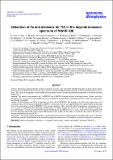Por favor, use este identificador para citar o enlazar a este item:
http://hdl.handle.net/10261/251484COMPARTIR / EXPORTAR:
 SHARE SHARE
 CORE
BASE CORE
BASE
|
|
| Visualizar otros formatos: MARC | Dublin Core | RDF | ORE | MODS | METS | DIDL | DATACITE | |

| Título: | Detection of Fe and evidence for TiO in the dayside emission spectrum of WASP-33b |
Autor: | Cont, D.; Yan, F.; Reiners, Ansgar; Casasayas-Barris, N.; Mollière, P.; Pallé, Enric; Henning, Thomas; Nortmann, L.; Stangret, M.; Czesla, S.; López-Puertas, Manuel CSIC ORCID; Sánchez-López, A. CSIC ORCID; Rodler, F. CSIC ORCID; Ribas, Ignasi ; Quirrenbach, Andreas; Caballero, J. A. CSIC ORCID; Amado, Pedro J. CSIC ORCID; Carone, Ludmila; Khaimova, J.; Kreidberg, L.; Molaverdikhani, K.; Montes, D.; Morello, G.; Nagel, Evangelos; Oshagh, M.; Zechmeister, Mathias | Palabras clave: | Planets and satellites: atmospheres Techniques: spectroscopic Planets and satellites: individual: WASP-33b |
Fecha de publicación: | 7-jul-2021 | Editor: | EDP Sciences | Citación: | Astronomy & Astrophysics 651: A33 (2021) | Resumen: | Context. Theoretical studies predict the presence of thermal inversions in the atmosphere of highly irradiated gas giant planets. Recent observations have identified these inversion layers. However, the role of different chemical species in their formation remains unclear. Aims. We search for the signature of the thermal inversion agents TiO and Fe in the dayside emission spectrum of the ultra-hot Jupiter WASP-33b. Methods. The spectra were obtained with CARMENES and HARPS-N, covering different wavelength ranges. Telluric and stellar absorption lines were removed with SYSREM. We cross-correlated the residual spectra with model spectra to retrieve the signals from the planetary atmosphere. Results. We find evidence for TiO at a significance of 4.9σ with CARMENES. The strength of the TiO signal drops close to the secondary eclipse. No TiO signal is found with HARPS-N. An injection-recovery test suggests that the TiO signal is below the detection level at the wavelengths covered by HARPS-N. The emission signature of Fe is detected with both instruments at significance levels of 5.7σ and 4.5σ, respectively. By combining all observations, we obtain a significance level of 7.3σ for Fe. We find the TiO signal at Kp = 248.0-2.5+2.0 km s-1, which is in disagreement with the Fe detection at Kp = 225.0-3.5+4.0 km s-1. The Kp value for Fe is in agreement with prior investigations. The model spectra require different temperature profiles for TiO and Fe to match the observations. We observe a broader line profile for Fe than for TiO. Conclusions. Our results confirm the existence of a temperature inversion layer in the planetary atmosphere. The observed Kp offset and different strengths of broadening in the line profiles suggest the existence of a TiO-depleted hot spot in the planetary atmosphere. © ESO 2021. | Versión del editor: | http://dx.doi.org/10.1051/0004-6361/202140732 | URI: | http://hdl.handle.net/10261/251484 | DOI: | 10.1051/0004-6361/202140732 | ISSN: | 0004-6361 | E-ISSN: | 1432-0746 |
| Aparece en las colecciones: | (IAA) Artículos (ICE) Artículos (CAB) Artículos |
Ficheros en este ítem:
| Fichero | Descripción | Tamaño | Formato | |
|---|---|---|---|---|
| 2021AA...651A..33C.pdf | 4,24 MB | Adobe PDF |  Visualizar/Abrir |
CORE Recommender
SCOPUSTM
Citations
32
checked on 18-may-2024
WEB OF SCIENCETM
Citations
32
checked on 25-feb-2024
Page view(s)
96
checked on 22-may-2024
Download(s)
56
checked on 22-may-2024
Google ScholarTM
Check
Altmetric
Altmetric
NOTA: Los ítems de Digital.CSIC están protegidos por copyright, con todos los derechos reservados, a menos que se indique lo contrario.
